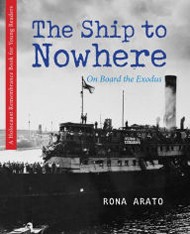The title of Rona Arato and Isabel Muñoz’s illustrated biography of Ruth Gruber (1911 – 2016) captures the essence of her life. A groundbreaking journalist, photographer, and activist on behalf of many social causes, she enjoyed a long and successful career despite the barriers placed against women in her fields. Rather than covering the full length of Gruber’s accomplishments, this book focuses on her formative years and her role as both a reporter and an advocate for the oppressed during World War II. Nothing Could Stop Her gives middle-grade readers insight into Gruber’s tenacity and talents.
Like many Jewish parents of that time, Gruber’s are proud of her academic achievements and enthusiastic about her ambitions. But as Arato repeatedly shows, Gruber’s career faces many obstacles. When her German professor at New York University strongly cautions his Jewish students to forget Yiddish, she remains proud of her identity. Later, in her work with refugees who survived the Holocaust, her fluency in Yiddish serves to comfort many of them. Studying for a master’s degree at the University of Wisconsin, Gruber encounters antisemitism thinly veiled as negative comments about “New Yorkers.” Again, the unstoppable young woman is undeterred.
Muñoz’s brightly colored illustrations, reminiscent of animation, portray the contrast between her youthful, stylish appearance and her incredible inner strength. Integrated into the story, too, are text boxes with additional points that provide the context of world events. These allow the narrative to present valuable information while also moving forward at an engaging pace.
Boarding with a Jewish family in Cologne while she pursues further studies, Ruth is encouraged to earn her Ph.D. in English with a focus on the work of Virginia Woolf. Although Gruber completes her doctorate in one year, she quickly realizes that subjects of greater urgency will soon determine the course of her career. The discrepancy between alarming developments in Germany and the attempt of German Jews to maintain a normal life foreshadows the impending disaster.
When, in 1944, President Roosevelt belatedly establishes a program to bring one thousand refugees to Oswego, New York, Gruber is sent to accompany them on a ship from Italy. Most of the group is Jewish; and when the Nazis attack the ship, some of the US soldiers complain they are being targeted because of the Jews on board. Gruber counters that “a refugee can be anyone who’s … displaced.” Rather than coming to the specific defense of the Jews targeted by Hitler, Gruber feels it is necessary to her argument to universalize their suffering — but to no avail. Her response does not grant her the soldiers’ sympathy. (One text box inadvertently reflects Gruber’s universalization, citing the incorrect figure that five million non-Jews, as well as six million Jews, were killed specifically to “purify” Europe. Nazi hunter Simon Wiesenthal invented the five million number because he, like Gruber, felt that the world was uninterested in learning only about the true fate of Europe’s Jews.)
Gruber is a little-known heroine whose story needs to be told. This book, distinguished by its engaging pace and illuminating art, ensures that she will not be forgotten.
Emily Schneider writes about literature, feminism, and culture for Tablet, The Forward, The Horn Book, and other publications, and writes about children’s books on her blog. She has a Ph.D. in Romance Languages and Literatures.





